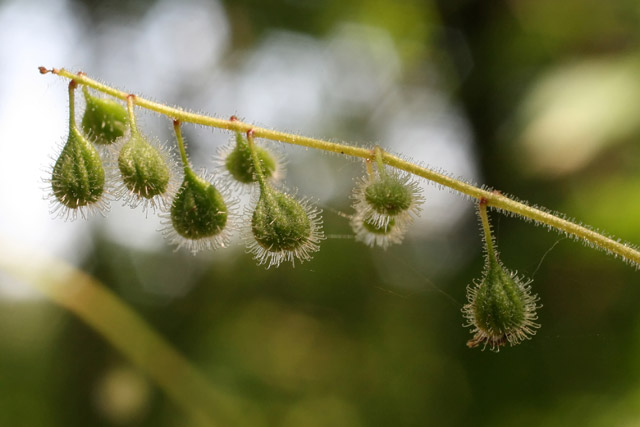 |
 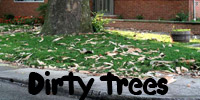 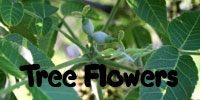 |
Welcome
to bobklips.com, the website of Bob Klips, a plant enthusiast living in
Columbus, Ohio. The Velvetleaf Underground (Abutilon theophrasti in the seed bank) August 7, 2008, Marion, Ohio. Residential and
commercial development are underway on former farmland along State
Rte. 95 at the eastern outskirts of the City of Marion,
Ohio. Earth moving activities associated with land clearing and
leveling often result in the establishment of large mounds of
soil.
Two long earthen mounds are visible in the panorama below. One, at the extreme left, extends straight away from the camera's point of view. The other mound runs across most of the remaining field of view, visible as a darkish band between the trees in the distance and the flat meadow with Queen Anne's lace in the foreground. Recent excavation of the meadow created the mounds. The uniform green of the mounds is attributable to their being covered by a dense stand of velvetleaf (Abutilon theophrasti, family Malvaceae). 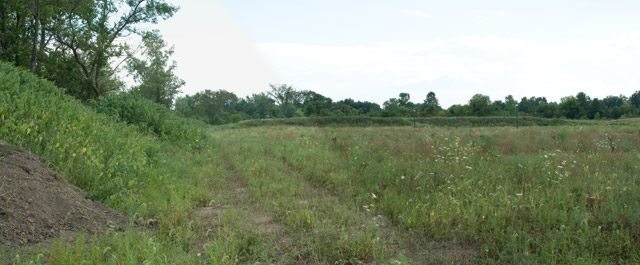 Newly created dirt mounds, August 7, 2008, Marion, Ohio, the site of many velvetleaf plants. These
mounds became occupied by the
velvetleaf monoculture during the first season after exposure, with the
plants no doubt originating from buried seeds. Viable seeds
lying underground that can germinate when exposed to moisture
and sunlight are termed the "seed bank."
Seeds of some species can live 100 years in the soil. This was decisively shown through a spectacularly long-running plant ecology experiment in which Michigan State University botanist William J. Beals in 1879 buried 20 vials of soil containing seeds of 21 different species of weed. Beals developed a protocol for their excavation and germination testing at 5-year intervals. (To extend the experiment the interval was increased, first to 10, and currently to 20 years.) The most recent withdrawls --there are 5 bottles remaining and the next will be dug up in 2020 --have consistently yielded only moth mullien (Verbascum blattaria, family Scrophulariaceae), plus, in some instances, traces of a few other species. 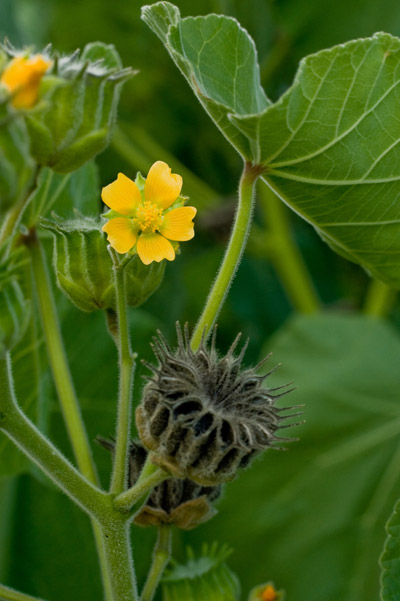 Velvetleaf, August 7, 2008, Marion, Ohio. Velvetleaf was not one
of Beal's test
plants. Nonetheless it seems to have substantial longevity in the seed
bank. It is an annual weed introduced from Asia in the 1700's that is a
serious crop weed, especially of corn. Its specific epithet
commemorates Theophrastus (371-287 BC), an ancient Greek scholar who
was a successor to Aristotle and specialized in plants. Velvetleaf
seeds are sometimes consumed from within by the same small bruchid
beetle species (Althaeus hibisci and A.
folkersti) that infect rose mallow hibiscus plants in our
area.
Nashville, Miami County, Ohio. August 3, 2008. Johnson grass (Sorghum
halepense)
is a tall grass, native of southern Eurasia, ranked
among the
world's 10 most noxious weeds. In Ohio, Johnson grass grows in
agricultural fields where it can severely decrease yields, and at this
time of year is conspicuous along roadsides and ditches. According to OARDC
the plant is common-named for Colonel William Johnson, who
introduced it in Alabama during the mid-1800's. As
the name Sorghum indicates, Johnson grass
is congeneric with sorghum (S. bicolor cultivars),
an important grain and syrup plant, especially in arid parts of the
world.
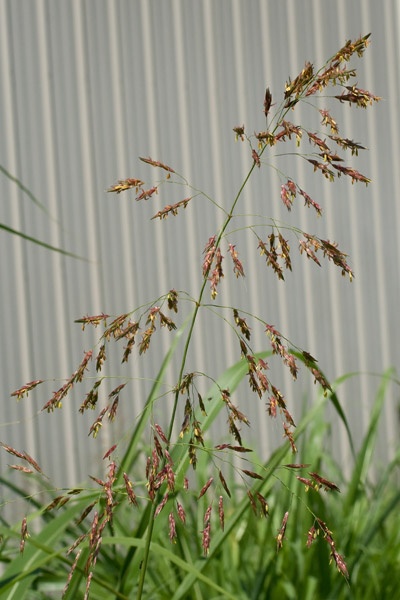 Johnson grass, Nashville, Miami County, Ohio, August 3, 2008. Grasses (family Poaceae) are wind-pollinated. Their flowers are small and simple, consisting of an ovary topped by feathery stigmas that are good at receiving pollen drifting in the air, plus a few stamens that consist of relatively large anthers (pollen sacs) dangling loosely on very slender filaments in an arrangement that excels at setting pollen adrift into the air. These simple flowers develop within a pair of scale-like coverings from which they stick out when mature. After pollination, the ovary develops into a one-seeded fruit with a very thin outer layer that is tightly adherent to the seed; this is termed a "grain" and it is a unique fruit type that only occurs in the grass family. 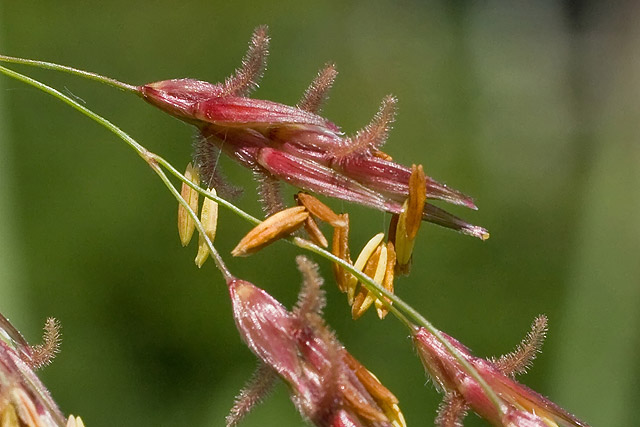 Johnson grass flowers, August 3, 2008, Nashville, Miami County, Ohio. Big hollow dead tree. Nashville, Miami County, Ohio August 3, 2008. In a generally
agricultural region north
of Dayton, Ohio, there's a small woodlot. In the woodlot there's a 2.5
ft. diameter, 8 ft. tall hollow tree trunk. Perched on the
tree
trunk is a turkey vulture (Cathartes aura
), a magnificent bird that the lovable
firebrand conservationist/author Edward Abbey (Desert Solitaire, The
Monkey Wrench Gang) nicknamed the "airy
purifier" through a loose translation of its scientific name.
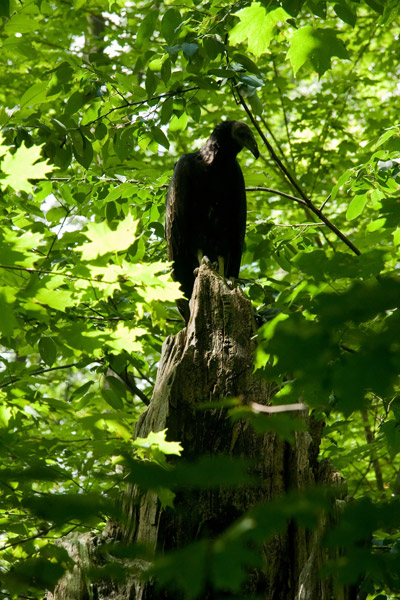 Turkey Vulture fledgling, August 3, 2008, Nashville, Miami County, Ohio This turkey vulture, although quite large, is neverthless incapable of sustained flight (it stayed put even when approached to within just a few feet). Its tail feathers, and perhaps its wings, are not fully grown in yet. 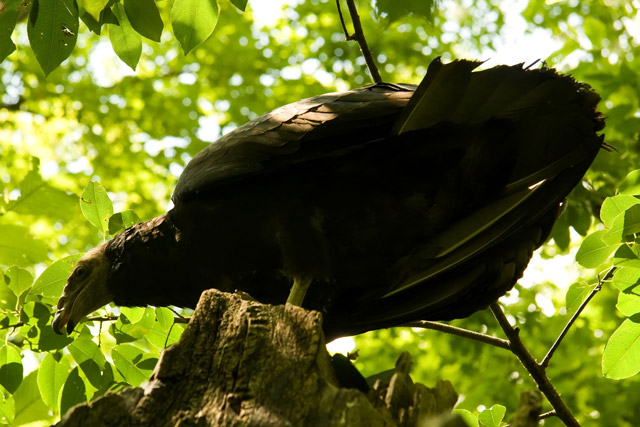 Turkey Vulture fledgling, August 3, 2008, Nashville, Miami County, Ohio. Inside the hollow tree,
about 8 feet deep,
is a second turkey vulture. It's reasonable to conclude these
birds were hatched in this tree trunk, although
surprisingly there are no nest accoutrements such as
lining material, food remains,
or fecal
material. It seemed remarkably fresh and clean, for a vulture's nest!
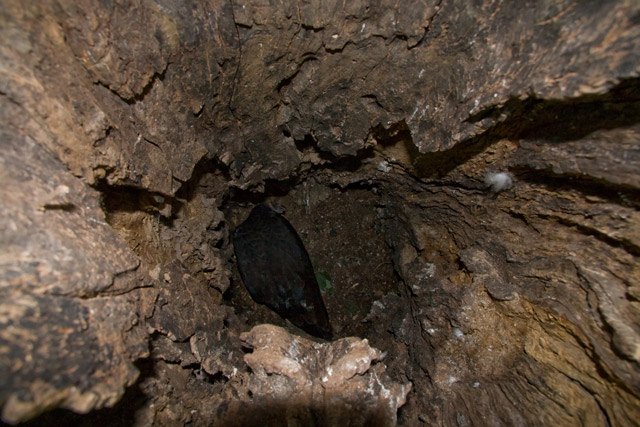 Turkey vulture deep in hollow tree, August 3, 2008, Nashville, Miami County, Ohio. It's amazing that this
bird, like its
sibling before it, will somehow manage to clamber up and out out of
this long narrow cylinder. While we were examining the nest area, an
adult TV came, apparently to attend to these birds, saw us and flew
away immediately, during which it tried to defecate on us.
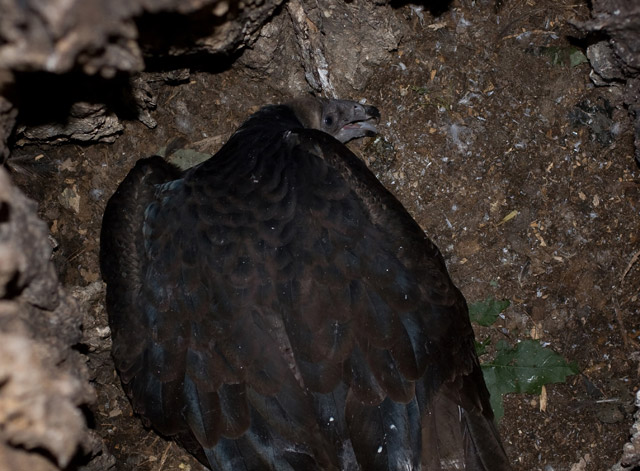 Turkey vulture nestling, August 3, 2008, Nashville, Miami County, OH. Turkey
vultures are common
throughout Ohio during summer, and are undoubtedly frequent
breeders. But the results from the first Ohio Breeding Bird Atlas
(1982-1987) showed strikingly few discoveries of strong
evidence of their breeding, with "probable" or "confirmed"
status recorded for only 28 blocks. That was fewer
than 5% of
the total
number of blocks they were observed in during the breeding season, as
most of the vulture observations were of roosting or soaring birds,
classified as "possible" breeders.
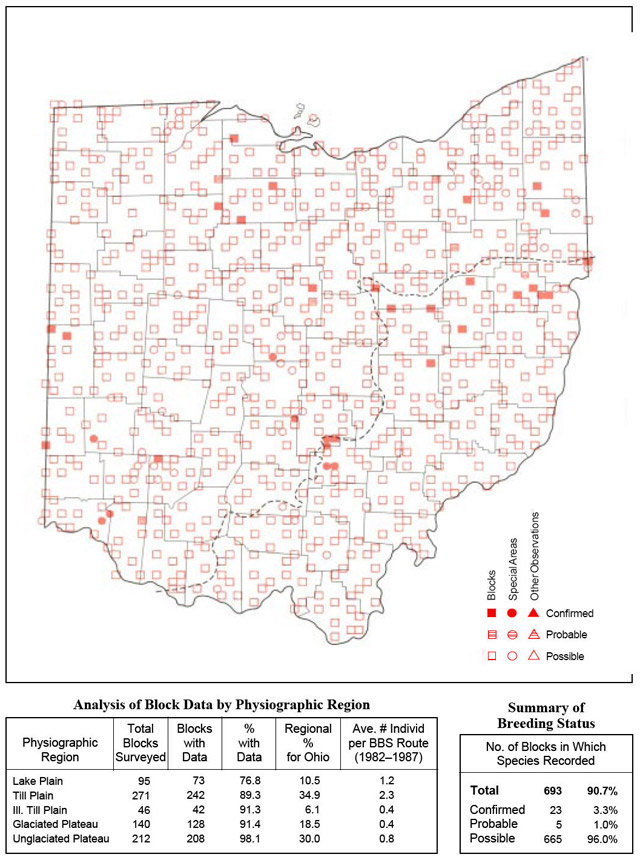 Ohio Breeding Bird Atlas 1 (1982-87) results for turkey vulture. The 2nd Ohio Breeding
Bird Atlas is well
underway, in year 3 of a projected 5 year field period. The state is
divided into 4000+ atlas blocks, each of which is approx. 10 square
miles. Atlasers sign up to "own" one or more blocks they will focus on,
taking care to visit all the different habitats within each
block during the breeding season, and to record specific
observations as evidence for possible, probable, or confirmed breeding.
Surprisingly, actually seeing nests with little chirpy birds in them is
unusual, and not necessary to achieve a high degree of confidence that
a
species is breeding. For example, hearing a male singing on suitable
territory on two occassions at least one week apart counts as
"probable" (coded T7). And an adult holding a caterpillar in
its
beak is assumed to be feeding nearby young, scoring "confirmed" (CF).
This turkey vulture sighting was entered into atlas block 65A5NE (West Milton) as "FY" (fledged young), although "NY" (nest with young) would have applied as well. Anybody can submit breeing bird observations, even if they don't "own" the block the observation was made in. Ohio Breeding Bird Atlas 2 has a pretty ambitious goal: 100% block coverage. There are still plenty of blocks avalable. The atlas is being amazingly well coordinated, with full use of internet technology for aquiring materials and uploading observations. Learn about the atlas at http://www.ohiobirds.org/obba2/. Pay attention. Calm down. Cheer up. Or not! --St. John's-wort is proven ineffective. Killdeer Plains, July 31, 2008 A
recent newpaper article (June
12, 2008, Columbus Dispatch) references
one of our most common wildflowers.
 All this hubbub is
about a weed of dry disturbed sites, Hypericum
perforatum
(family Clusiaceae), seen here at Killdeer Plains Wildlife Area, Marion
County, Ohio. Common St. John's-wort has oppositely arranged leaves
with neat translucent dots, a tuft of many slender stamens (with 3
slender styles) in the
center of each flower, and sharp black specks along the margins of the
petals. (The abbreviation for "saint" is the same as the
abbreviation for "street." Weird. Maybe this plant is actually "common
street John's-wort.")
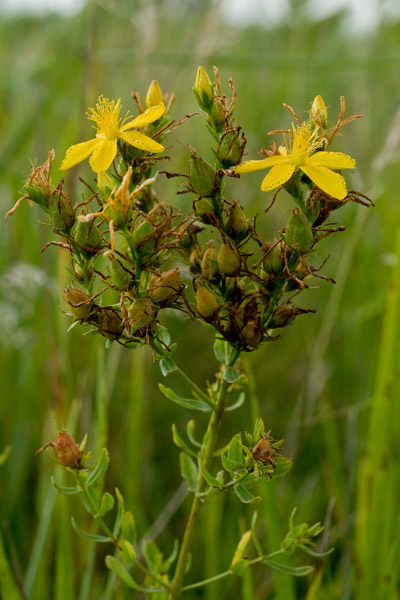 Common St. John's-wort, July 31, 2008, Marion County, Ohio. 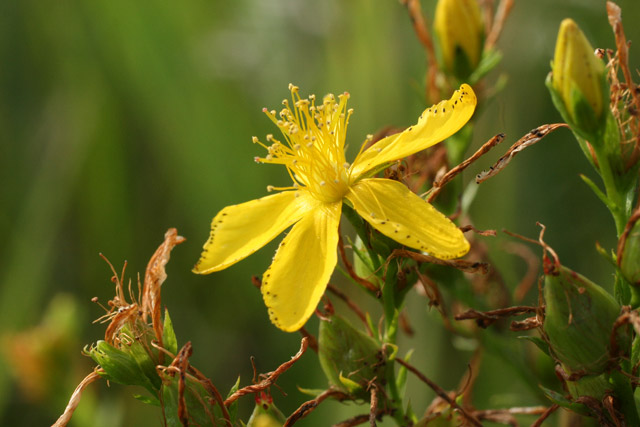 Common St. John's-wort flower, showing black spots on petal margins. July 1, 2008, Marion County, Ohio. 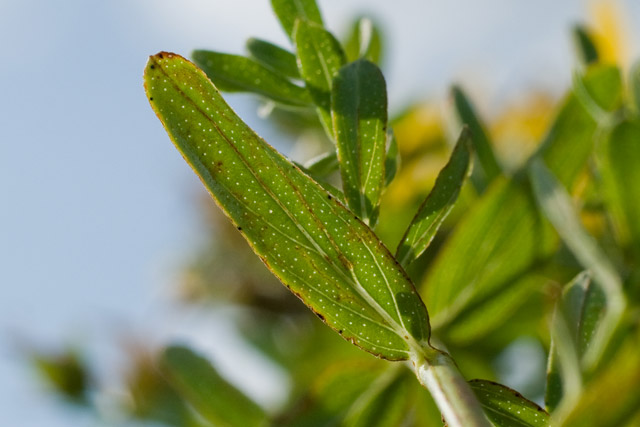 St. John's-wort leaf. July 31, 2008, Kildeer Plains, Marion County, Ohio. St. John's-wort is best
known as a folk
remedy for depression. Does its ineffectiveness in treating
ADHD signify it is also useless for depression? Probably. H.
perforatum is our only non-native species
of Hypericum.
There are 15 native ones, including three low shrubs
(the rest are herbs).
Another
common St. John's-wort in Ohio is spotted St. John's-wort, H.
punctatum. It sometimes occurs in disturbed settings
as does H. punctatum,
but can also be found in more natural ones such as the meadows
at
the edges of woods, as it was 2 weeks ago at the Pleasant Township Park
in Marion County, Ohio.
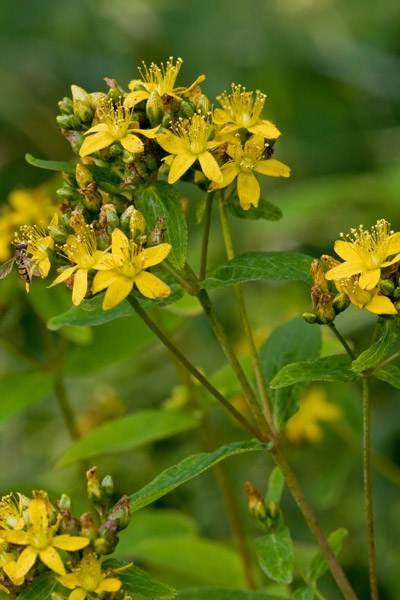 Spotted St. John's-wort. July 22, 2008, Pleasant Township Park, Marion County, Ohio. This native species is
taller, and the leaves are about twice as large as those of H.
perforatum. The petals have many small spots that
are scattered rather than being concentrated at the petal margins as in
H. perforatum.
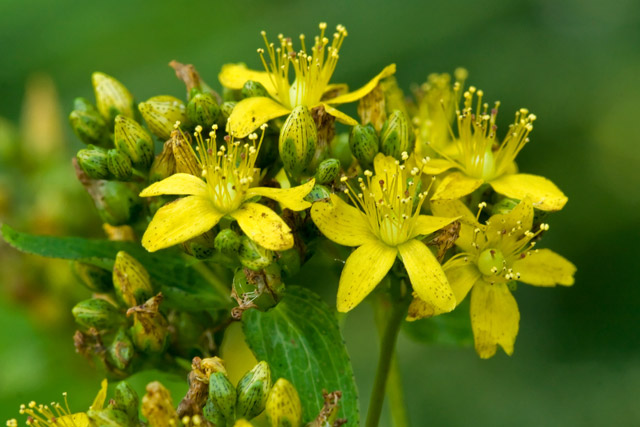 Spotted St. John's-wort flowers, July 22, 2008. Pleasant Township Park, Marion County, OH. Perhaps to make up for
the less dramatic
spotting on the petals, spotted St. John's-wort typically has black
spots on the leaves in addition to translucent ones. Wow. Botany is so
much more exciting than zoology!
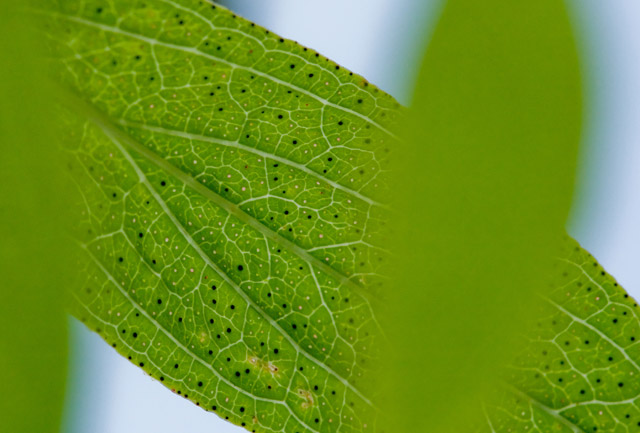 Spotted St. John's-wort leaf, showing black dots AND translucent spots. Shrubby St.
John's-wort, H. prolificum,
is fairly common in southern Ohio. It is currently flowering in an open
field at the Deep Woods Preserve in Hocking County, Ohio.
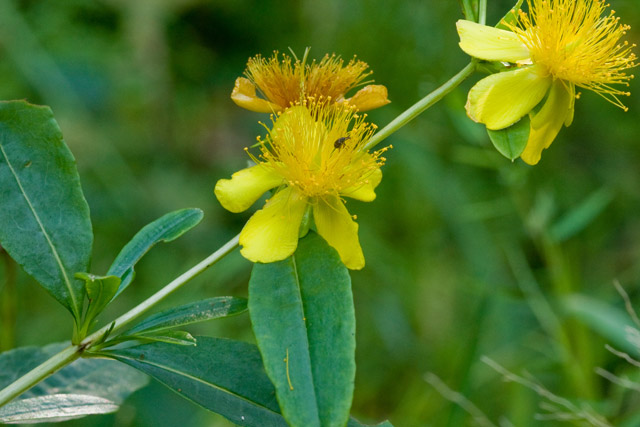 Shrubby St. John's-wort, July 30, 2008, Hocking County, Ohio. Purple fringeless orchid and a quasi-lookalike. Deep Woods Preserve, Hocking County, Ohio. July 30, 2008. The orchid family
(Orchidaceae) is a huge
one, with about 20,000 species worldwide, second only to the aster
family (Asteraceae), which has approx. 24,000 species. But by far the
bulk of orchid diversity is in the tropics. (There are only 49 orchids
in Ohio, compared with 263 aster family members.). One of our most
beautiful midsummer wildlfowers is the purple fringeless orchid, Platanthera
peramoena.
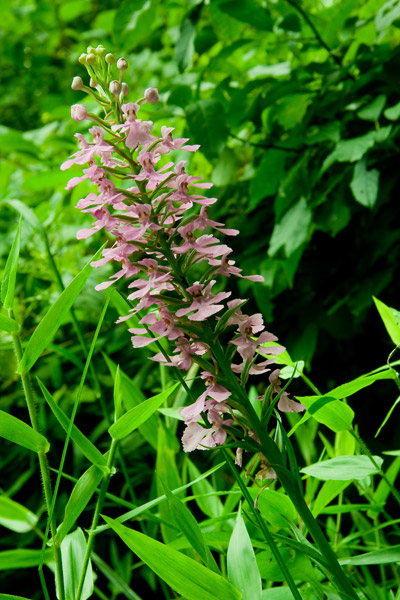 Purple fringeless orchid, July 20, 2008, Hocking County, Ohio. Wildflower lovers tend
to get very excited about orchids. They
have a lot of interesting traits. Orchids are monocots with the flowers
twisted upside-down. The male and female parts are fused together.
Their seeds are extremely tiny, almost dust-like, and lack nutritive
tissue for the developing seedling. Orchids depend upon partnerships
with fungi for at least some of their food. And orchid pollen, instead
of being distributed as individual grains, are adherent in waxy masses
called pollinia that get delivered in bulk to a female stigma. (Orchids
and milkweeds are the only plants that do that.) Many are quite rare,
and none are really abundant.
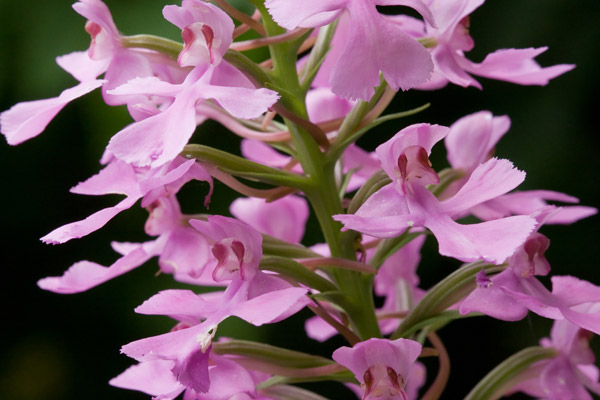 Purple fringeless orchid, July 20, 2008, Hocking County, Ohio A superficially similar plant that grows about the same time, and in similar habitats (damp soil) is a striking tall species of phlox, spotted phlox, Phlox maculata (family Polemoniaceae). 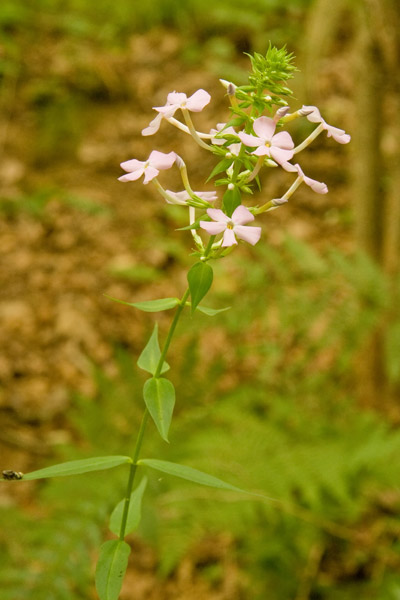 Spotted phlox, July 30, 2008, Hocking County, Ohio. It's interesting how
phlox flowers are
twisted in the bud. The corolla forms into a tube below the lobes of
the corolla. This is functionally similar to the orchid's spur (a
single petal).
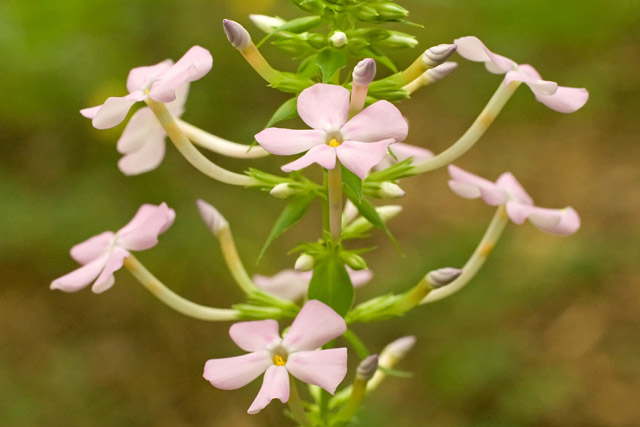 Spotted phlox, July 30, 2008, Hocking County, Ohio. Pleasant Township, Marion County, Ohio July 22, 2008 There
is a newly dug pond at
the recently established Pleasant Townhip Park in Marion County, Ohio.
The pond is being naturally vegetated by a variety of
aquatic plants and plant-like organisms. In the photo below we
see
an emergent wetland flowering plant, water-plantain (Alisma
subcordatum, family Alismataceae).
Black mustard 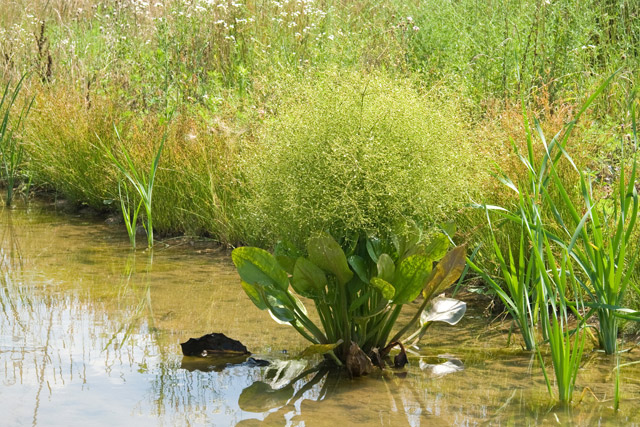 Water plantain at edge of pond at Pleasant Township Park, Marion County, July 22, 2008. The
"plant-like" organisms are
algae. Algae are
photosythetic but lack the structural and life-cycle complexity of true
plants, which are adapted for life on land. Algae are classified in the
Kingdom Protoctista (sometimes called Protista) along with mostly
unicellular organisms. Two intriguing algae are common here. One of
these is a filamentous green algae that might just be called "pond
scum," and it certainly doesn't look very appealing or distinctive in
the field.
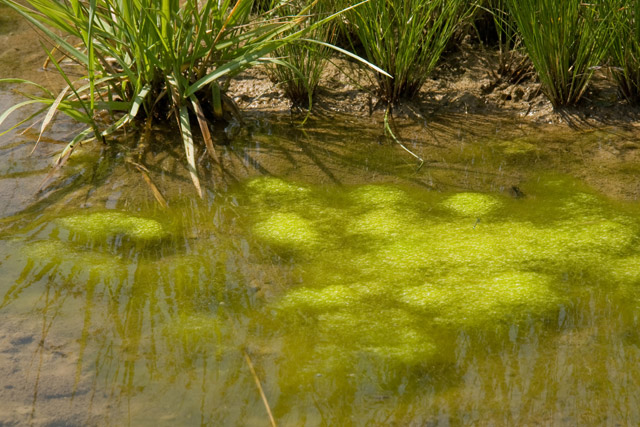 Spirogyra in pond at Pleasant Township Park, Marion County, Ohio, July 22, 2008. Through the microscope
though, the algal
filaments reveal a distinctive trait: the spiral chloroplasts that are
the basis for the name Spirogyra. Even the word
"Spirogyra" is
catchy; it was adopted as the name of two musical bands.
"Spirogyra" was a British folk band, and "Spiro Gyra" is an american
jazz/fusion band.
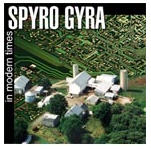 Spyro Gyra, the band. 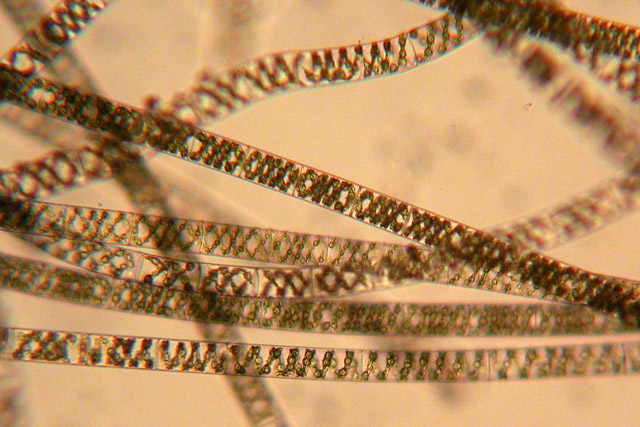 Green algae Spirogyra, microscope view, July 22, 2008. Another green alga is
well known because it's almost a plant! This is Chara, a
stonewort. Stoneworts are structurally complex algae that have
many morphological features, as well as supporting molecular data, that
indicate they are a close "sister group" to true plants.
Thus the immediate ancestor of true plants was likely a stonewort
or stonewort-like green alga.
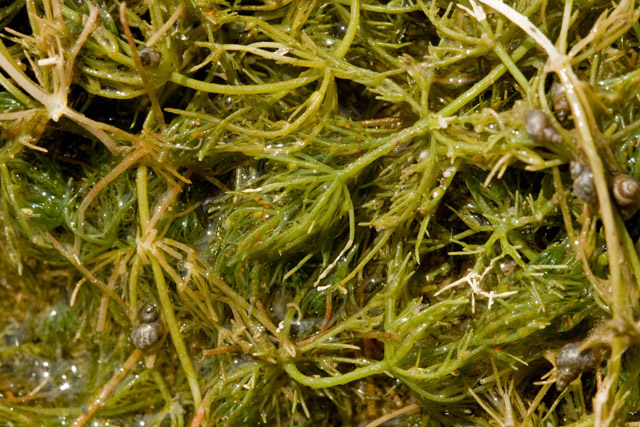 Chara, a stonewort, at Pleasant Township Park, Marion County, Ohio, July 22, 2008. Morral, Marion County, Ohio July 21, 2008 Black
mustard (Brassica nigra,
family Brassicaceae) is doing very well this year, competing for
attention with sow-thistle, Queen Anne's lace, and
chichory.
The seeds of this species, crushed and mixed with vinegar and some
spices, are made into the famliar condiment. Most years it can be found
flowering until late September or even early October.
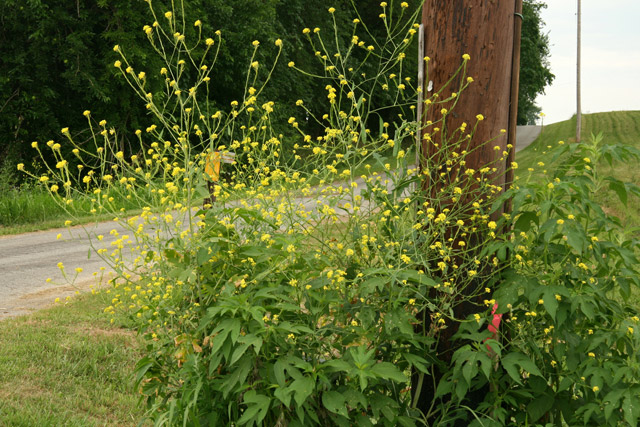 Black mustard, Morral, Marion County, Ohio, July 21, 2008. The Brassicaceae is one
of the most easily
recognized plant families. A traditional name, the
Cruciferae, meant cross (crucifix)-bearing, in reference to
the 4
wide-spreading petals. Mustards also have 4 sepals, and
the stamens, of which there are six, are
"tetradidymous,"
meaning that they are arranged in a distinctive pattern of four long
stamens plus two short ones. The fruit, a peculiarly modified capsule,
is unique as well. Depending upon the genus, the fruits are either long
and narrow (and termed a silique), or short and
squat (and called a silicle). The black mustard
fruit is a silique.
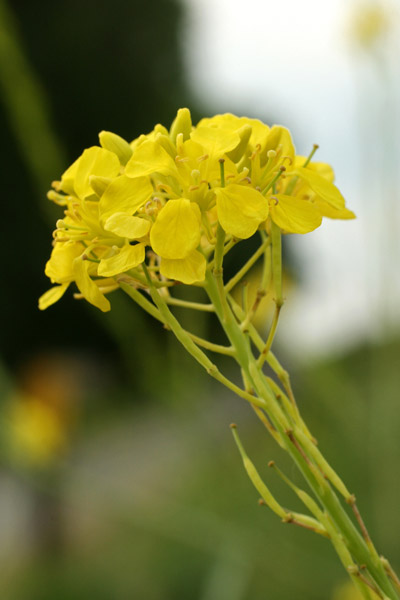 Inflorescence of black mustard, Morral, Marion County, Ohio, July 21, 2008. Tall bellflower Nashville, Miami County, Ohio July 20, 2008 One
of the most distinctive
and conspicuous wildflowers is bloomimg now, during the apparent "lull"
in the woods between spring/early summer wildflower
riots and
the aster displays of autumn. It's tall bellflower, Campanula
americana
(family Campanulaceae). Bellflower has a wand-like flowering stalk,
displaying well the type of sequential maturation of flower parts known
as "protandry," wherein the pollen receptive (female) stigmas are not
functional until later in the life of an individual flower. In the
photo
below, note how the older (lowermost) blooms have have their 3-parted
stigmas spread apart to receive pollen, whereas in the younger ones
they are still pressed tightly together.
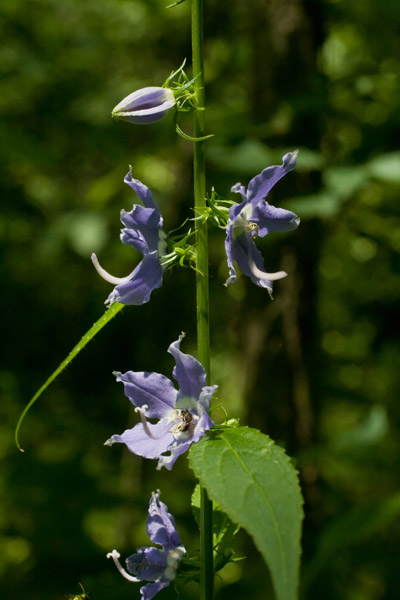 Tall bellflower, July 20, 2008, Nashville, Miami County, Ohio. 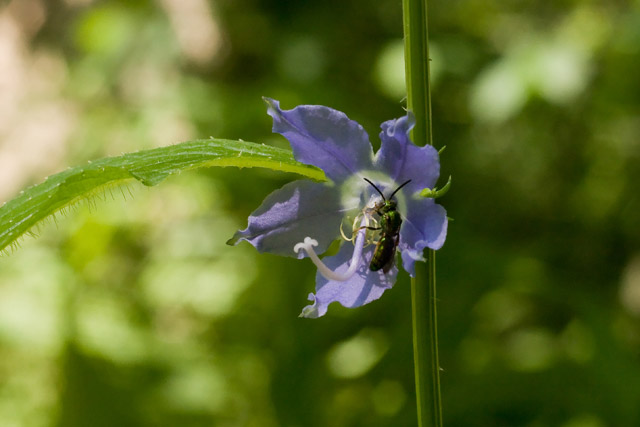 Tall bellflower visited by small native bee, July 200, 2008, Nashville, Miami County, OH. An enchanting plant. Pleasant Township Park, Marion County July 15, 2008 Everybody
is upset about invasive plants like garlic mustard, multiflora
rose, etc.,
spreading through the woods. But native plants, it seems,
perhaps rightfully, get a "free pass" even if they're
practically
all you can see on the forest floor. One especially
abundant native plant is the lovely enchanter's nightshade, Circaea
lutetiana (family Onagraceae).
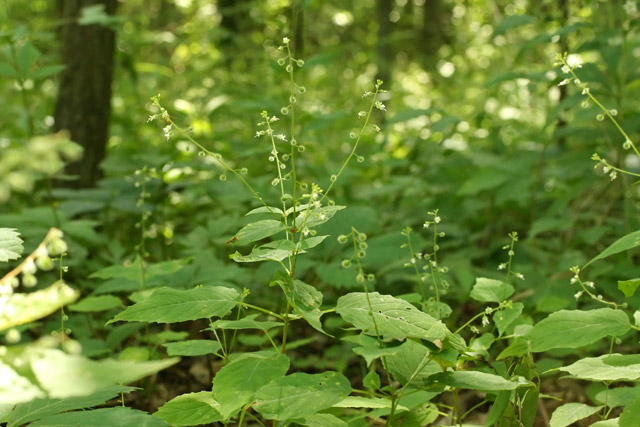 Enchanter's nightshade, Pleasant Township Park, Marion County, OH, July 15, 2008. Emchanter's
nightshade (unrelated to the true nightshades --toxic members of the
Solanaceae in the genus Atropa,
from which belladona is derived) is a good example of a plant with an
inferior ovary --the fruit-developing portion of the flower is located
below all the other flower parts. In the picture below, the ovary is
the swollen spiny portion. Note also how simple these flowers are, with
only two sepals, two petals, and two stamens.
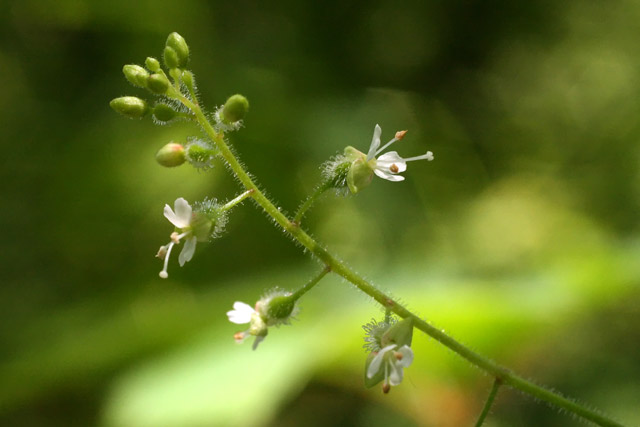 Enchanter's nightshade, Pleasant Park, Marion County, July 15, 2008. |
